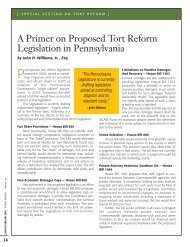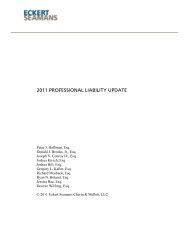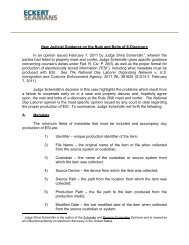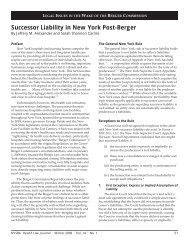Barrick, at *34-35.Furthermore, the written communication between counsel andan expert witness retained by counsel is not discoverable underthe Pennsylvania Rules of Civil Procedure to the extent thatsuch communication is protected by the work-productdoctrine, unless the proponent of the discovery request showspursuant to Pa.R.C.P. 4003.5(a)(2) specifically why thecommunication itself is relevant. As such, we also hold thatPa.R.C.P. 4003.3 immunizes from discovery any work productcontained within the correspondence between Appellants'counsel and Dr. Green.B. Release1. Maloney v. Valley Med. Facilities, Inc., 984 A.2d 478 (Pa. 2009)This important case held that a release of a principal, who was only liable under vicariousliability, does not release the agent. In Mamalis v. Atlas Van Lines, 560 A.2d 1380 (Pa. 1989),the Supreme Court held that release of the agent operated to release the principal who was liablefor vicarious liability. The release of the active tortfeasor released the passive tortfeasor. Laterin Pallante v. Harcourt Brace Jovanovich, 629 A.2d 146 (Pa. 1993), the court held that theopposite was also true.In Maloney, the plaintiff settled with the vicariously liable principal, and the releaseattempted to carve out the agent. The agent moved for summary judgment citing Pallante, andthe trial court granted the motion. The Superior Court affirmed, reasoning that there was a singleact that caused the damage. The Supreme Court reversed, essentially reversing Pallante, andholding that where the plaintiff releases a principal for vicarious liability only, and preserves itsclaim against the agent, the claims against the agent are not released.2. Tindall v. Friedman, 970 A.2d 1159 (Pa. Super. 2009)The court addressed the issue of whether a release including language that explicitlyreserves the right of the plaintiff to pursue excess insurance policy coverage applies to theMCARE fund. It is well settled Pennsylvania law that the court will scrutinize releaseagreements to a contract law analysis. Here, the plaintiff brought a medical malpractice claimagainst multiple parties including Dr. Schweitzer, the physician responsible for the reading of theMRI. Specifically, the plaintiff alleged that Dr. Schweitzer failed to follow the primary carephysician’s orders to analyze the plaintiff’s MRI results for a calcified hematoma or a neoplasm,the latter being cancerous. Due to this failed procedure, the cancer diagnosis was delayed andthe plaintiff endured an increased injury, additional medical costs, and a number of avoidableinjuries. Before the trial commenced, the plaintiff agreed to a partial release of Dr. Schweitzerthat provided in exchange for $400,000, the primary medical insurance coverage limit, hispersonal assets would not be pursued. Further, the release agreement expressly stated that theplaintiff reserved the right to pursue Dr. Schweitzer and all other defendants to collect primaryand excess insurance policies regarding this matter.142
The trial court concluded that for all intents and purposes, the MCARE fund acts as aninsurance provider for medical professionals and institutions. It is undisputed that the purpose ofthe MCARE fund is to pay medical malpractice claims for losses or damages incurred in excessof the basic professional insurance coverage. Further, medical professionals and institutions arerequired by law to contribute to the MCARE fund annually. The court reasoned that theMCARE fund was functionally equivalent to an excess insurance policy. The court, however,did not take into consideration the express language of the release agreement reserving the rightof the plaintiff to pursue excess insurance policies.In Mamalis, the court held that the release of a principal would then automatically releasethe agent from any further exposure to liability. See Mamalis v. Atlas Van Lines, Inc., 560 A.2d1380 (Pa. 1989). Here, the Superior court distinguished Mamalis on the grounds that this is not afull release agreement but instead merely intended and expressly stated as a partial release of aportion of the defendants exposure of liability. Therefore, the court held that the plaintiff wasentitled to continue to pursue the MCARE fund as it was not restricted by the release agreement.C. No Tort for Negligent Spoliation of EvidenceIn Pyeritz v. Commonwealth, No. 9 WAP 2009, 2011 Pa. LEXIS 2831 (Pa. Nov. 23,2011), the Supreme Court decided an issue with potentially frequent and far-reachingimplications – whether a tort exists for negligent spoliation of evidence. In Pyeritz:. . . Appellants sued Appellees based on the destruction ofpersonal property, to wit, a black nylon tree stand safetyharness, or belt, that allegedly was crucial evidence in aseparate civil action. The Pennsylvania State Police ("StatePolice") had seized this item during a criminal investigation ofa suspicious death. A state trooper had agreed to retain the beltin the custody of the State Police, apparently for a longerperiod of time than permitted by internal State Policeregulations, for Appellants' later use. However, the belt wasdestroyed before Appellants' counsel asked for its return.Appellants sued, and the trial court granted summaryjudgment to Appellees, which judgment the CommonwealthCourt affirmed. The Commonwealth Court held, inter alia,that no cause of action exists against a third party — someoneother than the original alleged tortfeasor — for negligentspoliation of evidence.Pyeritz, 2011 Pa. LEXIS 2831, at *1-2. The Pennsylvania Supreme Court 11 concluded thatPennsylvania law does not recognize a cause of action for negligent spoliation of evidence.In reaching the conclusion that it did, the Supreme Court determined that in weighingwhether to impose a duty – examining factors of (a) the relationship between the parties,11 Justice McCaffery wrote the majority opinion in which Chief Justice Castille, Justice Saylor, and JusticeBaer joined. Justice Eakin and Justice Todd wrote concurring opinions.143
- Page 3 and 4:
EMTALA CASES ......................
- Page 5:
Filing an Affidavit of Non-Involvem
- Page 8 and 9:
II.PROFESSIONAL LIABILITY - AN OVER
- Page 10 and 11:
The Superior Court reversed the tri
- Page 12 and 13:
to a third party pursuant to the st
- Page 14 and 15:
After approximately five months, De
- Page 16 and 17:
learned the day after the surgery t
- Page 18 and 19:
conduct to the delay in colon cance
- Page 20 and 21:
court admitted the expert’s testi
- Page 22 and 23:
(b)(c)other reasonable causes, incl
- Page 24 and 25:
corroborated his testimony. The cou
- Page 26 and 27:
husband’s estate. Plaintiff alleg
- Page 28 and 29:
Other notable federal cases arising
- Page 30 and 31:
The Superior Court found that in re
- Page 32 and 33:
§ 1303.512(b). The court, however,
- Page 34 and 35:
In Neidig v. United States, No. 07-
- Page 36 and 37:
Additionally, the Supreme Court not
- Page 38 and 39:
were not indicated for her conditio
- Page 40 and 41:
surgeon is the same as it would be
- Page 42 and 43:
It should be noted that the Superio
- Page 44 and 45:
Finally, the court held that the tr
- Page 46 and 47:
The Supreme Court of Pennsylvania r
- Page 48 and 49:
nurses deviating from applicable st
- Page 50 and 51:
certainty, the court reviews expert
- Page 52 and 53:
Under Pennsylvania law, the Court n
- Page 54 and 55:
testimony, Defendant presented his
- Page 56 and 57:
Following Cooper v. Roberts, 286 A.
- Page 58 and 59:
Plaintiff developed chronic diarrhe
- Page 60 and 61:
where payment is made by Medicaid w
- Page 62 and 63:
accomplished. In Valles v. Albert E
- Page 64 and 65:
In 1980, the Pennsylvania Superior
- Page 66 and 67:
Plaintiff had a routine monitoring
- Page 68 and 69:
Plaintiff’s Contract ClaimsThe Co
- Page 70 and 71:
is a failure to report changes in a
- Page 72 and 73:
unit to assure post-surgical patien
- Page 74 and 75:
sliced his wrist and arm with a raz
- Page 76 and 77:
licensed professionals for whom the
- Page 78 and 79:
(c)Limitations of Corporate Neglige
- Page 80 and 81:
Even more recently, our Superior Co
- Page 82 and 83:
(a)HMO IssuesIn McClellan v. Health
- Page 84 and 85:
affidavit submitted by Defendants o
- Page 86 and 87:
treatments while at VA’s faciliti
- Page 88 and 89:
[s]ubstantively, we believe that a
- Page 90 and 91:
The party claiming the benefit of t
- Page 92 and 93:
deprive (him) of civil rights guara
- Page 94 and 95:
found that the District Court was w
- Page 96 and 97:
With respect to fraudulent concealm
- Page 98 and 99: would be applied in situations wher
- Page 100 and 101: they had not raised them in the cou
- Page 102 and 103: (a)Informed ConsentUnder MCARE, a p
- Page 104 and 105: civil enforcement provisions and ma
- Page 106 and 107: MCARE also changes the manner in wh
- Page 108 and 109: whose death, in 2005, was allegedly
- Page 110 and 111: vicariously liable if the plaintiff
- Page 112 and 113: health center or its equivalent or
- Page 114 and 115: In Pennsylvania Medical Society, th
- Page 116 and 117: to any professional who is alleged
- Page 118 and 119: Since the 2005 amendments, there ha
- Page 120 and 121: ule, but who intentionally ignores
- Page 122 and 123: the original Complaint was delivere
- Page 124 and 125: foreclose all challenges against th
- Page 126 and 127: number of boxes), which was support
- Page 128 and 129: questions of professional judgment
- Page 130 and 131: deviated from any professional stan
- Page 132 and 133: The Third Circuit affirmed the Dist
- Page 134 and 135: claims and cross-claims remain agai
- Page 136 and 137: By an Amendatory Order dated March
- Page 138 and 139: The court acknowledged that there i
- Page 140 and 141: apply and that the trial court misa
- Page 142 and 143: Barbados had enough litigation-spec
- Page 144 and 145: E. Preemption of Vaccine Design Def
- Page 146 and 147: 2. Pa. R. Civ. Pro. 1036.1 - Reinst
- Page 150 and 151: (b) the utility of the defendant’
- Page 152 and 153: 2006). In this case, Plaintiffs bro
- Page 154 and 155: B. Elements of a Cause of Action fo
- Page 156 and 157: decision in Muhammad precluded Mr.
- Page 158 and 159: considered speculative “only if t
- Page 160 and 161: underlying cause of action involved
- Page 162 and 163: In Capital Care Corp., the Superior
- Page 164 and 165: The court found, however, to state
- Page 166 and 167: of reasonable diligence. The standa
- Page 168 and 169: not be set aside. On July 7, 2005,
- Page 170 and 171: complete bar to recovery. Since a l
- Page 172 and 173: On appeal, Plaintiffs claimed that
- Page 174 and 175: In Liggon-Redding, 659 F.3d at 265,
- Page 176 and 177: elieved of those minimum standards
- Page 178 and 179: elevant to the proceedings, the com
- Page 180 and 181: establish professional misconduct b
- Page 182 and 183: Upholding the Superior Court’s Or
- Page 184 and 185: Id.Rejecting revocation and suspens
- Page 186 and 187: order as a sanction under Rule 4019
- Page 188: {1009912]182









